The Covenant in context: Ballymena during the Home Rule crisis
Published in 1913, 20th-century / Contemporary History, Features, Issue 6 (Nov/Dec 2012), Revolutionary Period 1912-23, Volume 20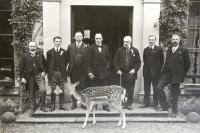
Sir James Craig and Sir Edward Carson in July 1913 at Galgorm Castle, seat of local linen magnate John Young (to Carson’s left); his son, ‘Orange George’, was local commander of the newly formed Ulster Volunteer Force. To Craig’s right is the local MP, Sir Arthur O’Neill. Deer wandered freely through the grounds. (Mid-Antrim Museum)
In the early twentieth century Ballymena, Co. Antrim, was a self-confident heartland of Ulster unionism. As a market town it stood at the heart of a thriving agricultural district. As an industrial centre it possessed textile mills and foundries, offering employment to thousands of workers and wealth to local entrepreneurs. A busy railway connected the town to Belfast. The vicinity was permeated with a muscular Protestant faith, possessing seventeenth-century covenanting roots and modified by evangelical piety two centuries later. Possessing their own distinctive Scots dialect and accent, locals presented themselves to the world as the citizens of a canny, forward-looking community, loyal to the Crown (and the half-crown).
‘Orange George’ Young and the UVF
It is not surprising, therefore, that the Ballymena area was one of the centres of unionist opposition to Home Rule a century ago. The MP at Westminster was Sir Arthur O’Neill, residing in the splendour of Shane’s Castle and descended from Sir Arthur Chichester, grand seigneur of the Ulster Plantation. Among the imperial heroes who resided in the district was Sir George White, defender of Ladysmith during the recent Boer War. At Galgorm Castle the Young family revelled in their domination of the mid-Antrim linen industry. By 1913, as the fight to prevent Home Rule intensified, George Young (known to his supporters as ‘Orange George’) became the local commander of the newly formed Ulster Volunteer Force (UVF), heavily involved in financing, structuring and training its mid-Antrim battalion and corresponding with his superiors in the unionist cause such as James Craig and Sir Edward Carson.
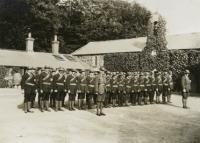
Local UVF men drilling in Galgorm Castle. Note the high quality of the uniforms and equipment, financed by the Young family. (Mid-Antrim Museum)
The Young family expended their wealth on equipping the local Ulster Volunteers with a smart paramilitary uniform that was a far cry from the basic attire worn by many Belfast units. Slouch hats, puttees, boots, bandoliers, haversacks, webbing and water bottles were purchased from military clothiers in London. Strict and extensive training regimes were undertaken, involving military drill, route marches, night manoeuvres and staged battles between companies of volunteers, whose simulated strife was presided over by an ‘umpire’. There was a special weekend camp of instruction for junior UVF officers. Attractive metal badges for proficiency were handed out to volunteers, as merited.When it came to acquiring arms, the local battalion staked a claim to some of the most coveted German rifles amongst the miscellany of weapons landed by unionist gunrunners at the nearby seaport of Larne in April 1914. Instruction in their use was sometimes given by local Presbyterian and Church of Ireland clergy, many of whom had been in the Officer Training Corps when at university. They matched their knowledge of musketry and drill with a religiously motivated enthusiasm for Britain’s ‘Protestant’ Empire and a detestation of the Irish Catholic Church, which they saw as heretical, superstitious and aggressive. Two companies in the mid-Antrim battalion had clergymen as commanders. What added fuel to local suspicion of a resurgent Roman Catholic Ireland was the fact that a local Catholic family and a local Protestant clergyman were connected to the main players in the infamous and newsworthy ‘McCann case’, in which a married couple and their offspring had recently separated over the hotly contested issue of the Catholic Church’s right to ‘ownership’ of their ‘mixed’ marriage and the religious affiliation of the children.
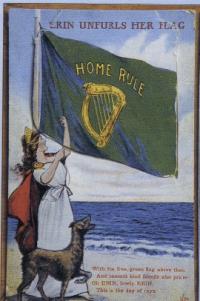
Pro-Home Rule postcards from the period. (Linen Hall Library; Mid-Antrim Museum)
Ulster Day, 28 September 1912
On Ulster Day, 28 September 1912, Ballymena was draped in Union flags as men aged sixteen and upwards left their homes to enter civic and church buildings, where they added their names to the document known as the Solemn League and Covenant. Women put their names to a supplementary document known as the Declaration. Solemn services were held in almost every Protestant church, from whose pulpits sincere homilies were delivered that echoed the theme of the hour—determination to resist Home Rule (with divine help) and a proud Protestant identification with the British Empire. The sentiments chimed with statements made on mid-Antrim’s political platforms by industrialists, politicians, clergy and merchants, who proclaimed that Ballymena should not allow itself to be ‘dragged down’ by an Irish administration to the economic and cultural level of the rural south and west. Speaker after speaker claimed that nationalists were neither able nor willing to protect Ballymena’s economic achievements or its sturdy, hard-working inhabitants. A narrative that deals exclusively with this ebullient Ballymena unionism does not, however, constitute the complete story of mid-Antrim during the Home Rule crisis. Not all local Protestants feared the Gaelic culture that existed in close proximity to Ballymena, especially in the scenic heartland of the coastal glens, where the regular Feis na nGleann delivered a buoyant example of Irish national self-renewal and promised a golden dawn under Home Rule. Indeed, Rose Young, George Young’s sister, who lived in the loyal citadel of Galgorm Castle, was a fluent Irish-speaker and an enthusiastic member of the Gaelic League. She taught the language at several classes throughout the district. And Sir Roger Casement, senior diplomat and humanitarian who had done so much to expose the murderous nature of colonial rubber plantations in Africa and South America, would soon develop into a highly active nationalist, even though he had arrived in Ballymena as an orphaned relative of the Young family, who had brought the young boy north in order to be schooled at an educational institution that would soon evolve into Ballymena Academy, the district’s most prestigious school.Captain Jack White, the son of Sir George White VC, also possessed political views that were strikingly different from his father’s. Jack had left the army to pursue a robust, radical and adventurous life. Recently returned from an anarchist commune in England, by 1912 he was manifesting enthusiasm for revolutionary socialism and in the following year, amidst the turmoil of the Dublin Lockout, he would help form the Irish Citizens’ Army with another ex-soldier, the labour activist James Connolly.
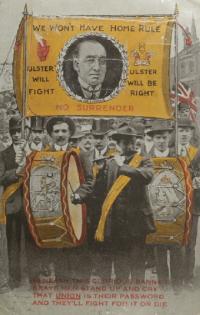
Anti-Home Rule postcards from the period. (Linen Hall Library; Mid-Antrim Museum)
Industrial unrest
It would be a mistake to see mid-Antrim’s working class as an obedient squadron of proletarian foot-soldiers. One feature of the pre-war years, despite the much-vaunted prosperity of Ballymena, was the regularity of industrial stoppages in the district, mirroring labour unrest elsewhere in Britain and Ireland. The most significant was a strike by girls employed at the Young family’s huge Braidwater mill. The installation of new machinery in 1911 led to difficult working conditions for many of the girls, resulting in a mass protest that shut down the premises for several days. Female workers marched through the streets, singing popular airs and shouting slogans. Other strikes focused on working conditions, including a lengthy stoppage by men and women at a busy paper mill several miles from the town. The situation was resolved after careful arbitration—but only when union officials travelled from England to take part in negotiations. It would also be a mistake to see all of Ballymena’s employers as deeply conservative figures who were interested exclusively in accumulating wealth and safeguarding their future through automatic conformity to the unionist project. John Dinsmore, whose textile-manufacturing business was situated in the mid-Antrim area, was a scathing critic of the ‘linen lords’ of the district, proclaiming that these rich men were interested in ‘loot’ rather than ‘loyalty’. Dinsmore also made it known in several somewhat histrionic letters to the local paper that he was prepared to increase his employees’ wages if he thought they were getting an unfair deal. Scathing replies in the same letter columns accused Dinsmore of being a sanctimonious, would-be Francis of Assisi. It is probably wrong to see Dinsmore as a Protestant nationalist who believed wholeheartedly in the virtues of a Dublin parliament. He did despise the unionist leadership in mid-Antrim but he was a pragmatic Liberal Party member who at an early stage in the Home Rule crisis advocated the temporary partition of Ireland as a regrettable but necessary way of diminishing the immediate volatility of the political situation.So there is plenty of evidence that opposition to Home Rule was not the only preoccupation of Ballymena in the second decade of the twentieth century. The growth in class-consciousness and Ireland’s ongoing cultural reawakening mattered to life in mid-Antrim. So too did the growth of female self-awareness, in the shape of a popular unionist women’s group and the occasional arrival of suffragettes to hold open-air meetings in Ballymena. With regard to labour issues, it is interesting to examine the local election results for the town in 1920. Labour candidates had a chance to stand for the first time in Ballymena, hoping to benefit from the fact that proportional representation (PR) was now in use to calibrate the poll. In the working-class district of Ballymena known as Harryville, where most citizens worked in local mills and foundries, Labour candidates gained fully 40% of the vote, double the percentage that the party gained throughout Ireland as a whole. This figure indicates that at the end of a turmoil-ridden decade of partisan politics socialism still had potential as a political force in working-class mid-Antrim—an area that would come to be seen only as a bastion of conservative social and religious values and a heartland of ‘not-an-inch’ unionism. Sustained attacks on local premises and local policemen by the IRA during 1921–2 soon altered the political atmosphere. So too did vigorous speeches and sermons by ‘Orange George’ and the Ballymena clergy about the looming Bolshevik menace of atheistic socialism. After 1920 serious electoral support for Labour did not survive.
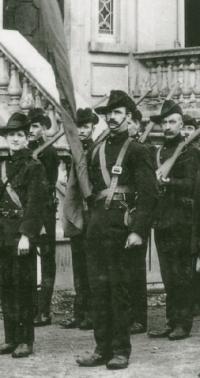
Captain Jack White on parade with the Irish Citizen Army. A mid-Antrim native, he developed political views strikingly different from his father, Sir George White VC. (Mid-Antrim Museum)
Catholics
An examination of the 1911 census, just before the Home Rule crisis began, reveals that in some parts of Ballymena up to a third of the population was Catholic. Although the overall percentage rarely rose above 20%, except in some outlying rural areas, there were few streets or townlands in mid-Antrim where Protestants did not live alongside Catholic neighbours. A Catholic middle class with commercial interests and professional standing had grown rapidly in Ballymena and met regularly to discuss politics and literature in the Catholic Literary and Debating Society. One local businessman who attended its meetings had become a successful entrepreneur, owning a bottling plant that employed a sizeable workforce and winning prizes for soft drinks in international competitions. An outlet for nationalist values and viewpoints had been afforded by the arrival of Irish local government at the end of the nineteenth century. In Ballymena there was now a significant Catholic presence in the civic affairs of an ‘officially’ Protestant community.In 1912, the year of the Covenant, a local lawyer called John Patrick McCann challenged a senior Presbyterian clergyman by instigating a libel case against him in the High Court in Dublin. McCann argued that the clergyman in question had recently stated that as a Catholic solicitor he would not treat his Protestant clients fairly. In truth, there was bad blood between McCann and the cleric in question. This derived from the infamous McCann ‘mixed marriage’ case, noted earlier in this article. John Patrick McCann was the brother of the man in this sectarian wrangle, and the Ballymena cleric whom he was challenging in court was the minister who had married the ill-fated couple. The result of the legal proceedings was defeat for McCann and civil unrest in the town, where the young lawyer’s effigy was burnt on a pyre. Nevertheless, it is apparent that a self-confident, educated Catholic middle class, buoyed up by the successes of the Home Rule movement and the creative energy of the Gaelic Revival, was becoming ever more assertive in the Ballymena district.
Epilogue
Although unionism in Ballymena and its hinterland was a force throughout the early years of the twentieth century, strong currents did flow in all kinds of political directions. Perhaps it should not surprise us, then, that this distinctive vicinity helped give birth to interesting turbulence in unionist culture, beginning in the 1960s. During that decade, a son of Sir Arthur O’Neill, the former MP and owner of Shane’s Castle, continued in his father’s political footsteps. His name was Terence O’Neill and although he had never met his soldier father, who had died in the early days of the Great War, he would become a captain in the British Army and in due course rose to be the fourth prime minister of Northern Ireland. The continuity and stability of ‘big house’ unionism had never seemed more secure. That unionism’s patrician ethos and imperial discourse could not survive long, however, within a new global era where human rights were the watchword, where empires had been blown away by the ‘winds of change’ and educational opportunity was extending the self-confidence of those who lived with minority status in Northern Ireland’s divided society. Shane’s Castle and Galgorm Castle had not been built to wall out the kind of challenge that Ulster unionists now faced.Instead, the focus shifted to places where the fight for the Union could be officered at ground level—locations such as the small, independent church that had been built just a short distance from the gates of Braidwater mill in the middle years of the twentieth century. In that church a fundamentalist pastor called James Kyle Paisley held sway, and by the late 1950s his son Ian was evolving into a street-preacher and unionist ideologue with a sharper identity than Orange George or the son of Sir Arthur O’Neill, whom he would soon vanquish politically.
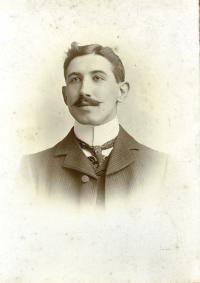
John Patrick McCann—in 1912 he took a libel action against a local Presbyterian minister for claiming that as a Catholic solicitor McCann would not treat his Protestant clients fairly. The same minister had earlier married McCann’s brother, an ill-fated ‘mixed marriage’ that ended in an acrimonious sectarian wrangle over the religious affiliation of the children. Despite losing the case (and having his effigy burnt for good measure), McCann represented a self-confident, educated Catholic middle class in the town. (McCann family)
Yet Ian Paisley would also advocate, at various stages in his career, the alliance of religion, politics and pro-Union insurgency once seen so vividly in Ballymena during the Home Rule crisis. Although Braidwater mill, with its impoverished workforce and wealthy owner, would fade away in a time of industrial and political change, the politician who emerged in that factory’s shadow would rise to remarkable prominence. Imbued with street-wise self-belief, he would pursue a political career whose success depended on a rhetoric better understood at the factory gate than in the drawing rooms of local mansions. He would offer a politics rooted in the stark, unashamed vehemence of the Protestant Reformation, a religion that had been the theological lifeblood of the seventeenth-century Plantation of Ulster. Ian Paisley, however, was also the progeny of the Reformation’s bold assault on hierarchy, tradition and privilege. There can be little wonder, then, that it was Ian Paisley, with his working-class Ballymena origins, who sat down with the leaders of Sinn Féin in recent years to share executive power and to discover an unlikely bond with a republican movement which possesses revolutionary leadership and a working-class ethos that would have repelled the old guard of traditional unionist leadership. HI
Philip Orr is a writer, researcher and teacher. He is the co-author of a play about the year 1912, which has toured Northern Ireland in recent months.
Further reading:
T. Bowman, Carson’s army (Manchester, 2008).P. Orr, New perspectives: politics, religion and conflict in mid-Antrim (Ballymena, 2011).E. Phoenix, Feis na nGleann (Belfast, 2005).A.T.Q. Stewart, The Ulster crisis (London, 1968).
A New Perspectives interactive e-learning website has been developed to support classroom teaching of the Home Rule period by focusing on the local story in Ballymena during the 1911–14 period. Visit http://newperspectives.thebraid.com/ to find out more.
















